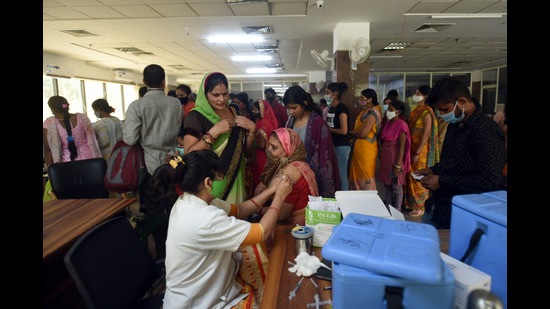On Covid-19 vaccination, don’t be complacent
Vaccine demand can be generated through the development of targeted action plans addressing both access issues and hesitancy. With only a third of the eligible population fully vaccinated, we don’t have the luxury of time
The one billion Covid-19 vaccine dose landmark is a significant achievement, but it shouldn’t eclipse the long way ahead. The government plans to fully vaccinate the entire adult population by December. This represents 940 million people or 1.8 billion doses — not including potential booster doses or children’s vaccination. At the current pace, it will take five months to complete this target. But the more the vaccination rate increases, the more challenging it becomes to vaccinate the remaining groups.

It is essential to understand which populations are unvaccinated across geographic, socioeconomic and demographic factors. First, we know from the routine immunisation programme for children in India that the vaccination rate is highly correlated with socio-economic status. The immunisation coverage of children in the wealthiest quintile (70%) is higher than in the lowest quintile (53%). This data, on an economic basis, is lacking for Covid-19 vaccination.
Second, some states, such as Bihar, Uttar Pradesh and Tamil Nadu, still have about a third of their eligible population fully unvaccinated. These states should be given additional resources to scale-up their campaign. Tamil Nadu has been singled out for having high rates of vaccine hesitancy, but further research is needed to better understand the reasons behind the numbers in all these states.
Third, only 60% of the 45-59-year-old category has received one dose or more of the vaccine, while they represent a higher risk group than the better vaccinated 18-44 age group. Finally, research we conducted in West Bengal earlier this year pointed to an urban/rural divide.
In parallel, we should encourage partially vaccinated individuals to complete their vaccination schedule. They represent over 700 million people. As with most multiple-dose vaccine regimens, drop-outs are expected after the first dose. For instance, coverage for the measles vaccine is 79% for the first dose and 27% for the second dose due after six months.
For both unvaccinated and partially vaccinated populations, the main challenge is vaccine indifference. As the number of Covid-19 cases decreases, people lose the motivation to protect themselves. In a vaccine hesitancy research we conducted before the second wave, returning to school, restarting the economy and returning to normalcy were listed as much higher incentives than the health benefits of getting vaccinated. Now that schools and businesses have reopened, the motivation to get vaccinated may shrink.
Vaccine demand can be generated for each of these under-vaccinated populations through the development of targeted action plans addressing both vaccine access issues and vaccine hesitancy.
The main access issues include lack of information, inability to travel, and the digital divide. This has been partially addressed recently but setting up vaccination points in multiple places (pharmacies, markets, religious places) to make information, registration and vaccination easily available for everyone is important.
Regarding vaccine hesitancy, our studies show it is mainly driven by the fear of side-effects and a general sense of distrust and fear of going to a hospital. In addition, some believe they do not need the vaccine as they are healthy or because Covid-19 is not a serious health concern. Addressing vaccine hesitancy requires launching both campaigns to encourage complete vaccination and targeted campaigns for unvaccinated populations. These campaigns should be informed by regular research as people’s attitudes and perceptions of the vaccines can evolve rapidly. Most importantly, identifying the right channels of information is crucial to ensure that messages reach their audience. Community leaders, local doctors and NGOs and vaccinated community members were often cited as reliable sources of information on vaccines.
The number of first doses administered has already started to drop — from over 30 million first doses administered weekly in August and September to 20 million in October. With only a third of the eligible population fully vaccinated, we don’t have the luxury of time. The second wave was a harsh reminder that complacency is not an option during a crisis.
Sofia Imad is a junior fellow and Anushka Bhansali is an analyst at the IDFC InstituteThe views expressed are personal
Continue reading with HT Premium Subscription




